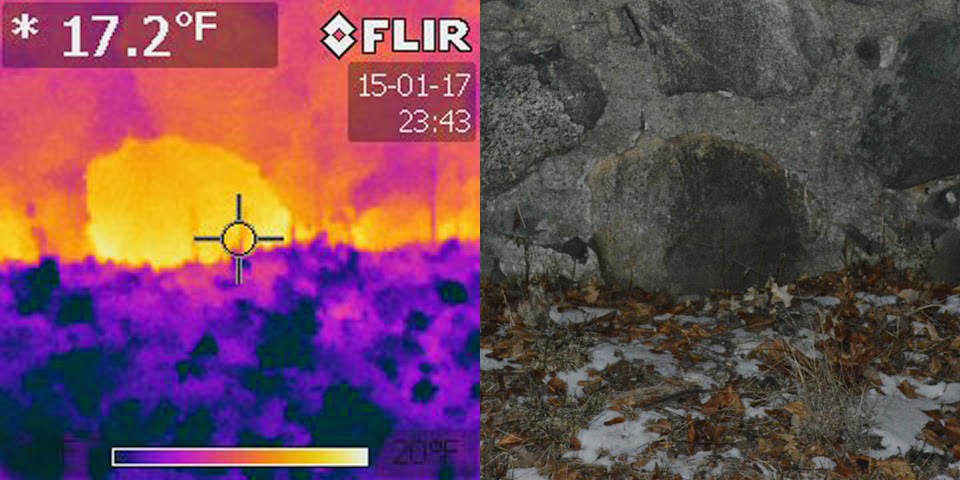It certainly shouldn't be surprising that running electrical devices are hot, but it still surprised me to see how warm my wall phone was compared to the wall around it. It looks like the electronics are on the right size of the phone.

And the nearby refrigerator is kicking out some heat on the lower right. Ironic that a device used for cooling actually creates heat, but that is how thermodynamics works. Sometimes when we let our turtle roam the floor we find he parks himself at that location.

My two Dewalt battery chargers show how much things have improved over time. The charger at the top of the image (middle really) is an older unit and is heating the battery. The lower one is a modern Li-Ion charger that isn't hot at all. Both batteries were long since fully charged when the picture was taken so I don't know why the top one is continuing to be charged.
Water steals a little bit of energy from the air when it is evaporating so wet objects are slightly colder. I hadn't even noticed the drops of water on the floor unit they showed up in the IR image.
I was also surprised to see the towels on the front of the oven looking so cold until I realized they are put there to dry. The "cold spots" really indicate the wet spots.
For IR cameras to work well, the objects they are imaging should have an "emissivity" value near one. The emissivity of a surface of a material is its effectiveness in emitting energy as thermal radiation. A perfect emitter has a value of 1.0 and real surfaces have lower values. Fortunately a lot of different building materials have emissivity in a close range from 0.9 to 0.95 meaning that reasonable thermal images can be made without correcting for the emissivity of every different object in the image.
But some materials are problematic, such as polished copper. Polished copper has an emissivity of only 0.04 and the impact of that can be seen in the image below. The copper pipes (which carry hot water for hydronic heating) in the image have been painted black over the middle section. So temperature reading where it is painted black should be reasonable accurate. In this case the yellowish color puts the temperature nearer the higher end of the scale which is 150°F.
But in the unpainted section of the pipe, towards the right of the image, the color is a very dark purple which would put it closer to the low end of the scale, 56°F. This is obvious a big discrepancy and something to be careful about when imaging shiny surfaces like metal.
There is also the possibility of getting a reflection in a surface just like taking a picture in a mirror. In an attempt to image a glass door, I got the image below which shows my thermal image reflected in the surface of the glass. It is unfortunate that glass has this issue because windows are one of the places that I would really like to get good thermal images from because they are a significant source of heat loss from my home. I guess the lesson here is to interpret images taken from glass surfaces very careful and with some skepticism.
One area of my home that I've been working to insulate is the concrete basement walls. After I finished insulating them, they were much better but still were warmer on the outside than I expected. So there might be something else going on with the concrete than just conducting heat out of the home..
The two images below are of large rocks or granite in the neighborhood. The rocks are much warmer than the surrounding earth. So what is happening?
Here is what I think is going on. These rocks are buried deep into the ground and it is reasonable to expect that they are in good thermal communication with underground soils which are probably 50°F at a level of 4 feet underground. So perhaps the rocks are conducting some of the heat out of the deep soil to the surface.
Possibly the same thing is happening with the concrete foundations walls of my home.
One thing is for sure, the heat seen from these rocks is not lost from any home because they are far from any home. So there are some naturally occurring variations in temperature that will be seen outdoors.
The final set of three images calls into question the accuracy of this FLIR i7 camera. The camera has the ability to "lock" the scale so the min/max temperature range doesn't change with every image. For these images, the scale was locked between 9°F and 20°F. But it is clear that the images are dramatically different despite being taken within seconds of each other of the same area of the house. I suspect this is some sort of thermal calibration (for the sensor temperature) that is not working well. But it is a very unfortunate defect in a $2000 camera and can make a mess of a series of carefully taken images.. If anyone knows what the issue is (operator error perhaps) please let me know.








No comments:
Post a Comment